Overview
The article explores the profound meaning and evolution of symbols in sports, emphasizing their vital role in nurturing connections among fans and shaping brand identity. It reveals a common challenge: the struggle for teams to resonate emotionally with their supporters. Sports symbols, including logos and team colors, do more than merely represent teams; they evoke deep emotional responses and foster a sense of community spirit. This connection is essential, especially in today's fast-paced digital age. Yet, the article also addresses the controversies surrounding cultural representation, highlighting the importance of adaptability in our ever-changing landscape. By understanding these dynamics, we can create a more inclusive and engaging environment for all fans.
Introduction
Symbols in sports transcend mere logos or colors; they embody the identity and spirit of teams, forging profound emotional connections with fans. Yet, as these emblems evolve—from ancient representations to modern branding strategies—they face significant challenges. The need for cultural sensitivity and the impact of digital innovation can complicate this journey.
How can sports organizations navigate these complexities? It’s essential to create symbols that resonate authentically with their audience while honoring diverse cultural narratives. By fostering a deeper understanding of these emotional ties, organizations can cultivate community and loyalty among supporters. Together, we can explore ways to ensure these symbols not only represent teams but also reflect the rich tapestry of the cultures they belong to.
Define Sports Symbols: Meaning and Function
Symbols in sports encompass a variety of visual elements, including logos, team colors, mascots, and uniforms, that represent a sports team or organization. The symbols in sports play a crucial role in fostering a sense of belonging among fans, enhancing brand recognition, and forging emotional connections.
Consider the iconic 'Swoosh' of Nike; it not only represents the brand but also stirs feelings of athleticism and accomplishment within us. Similarly, team colors can significantly influence fan behavior and perceptions. Research in color psychology reveals that certain hues can elevate team spirit and loyalty, reminding us of the power these emblems hold.
Ultimately, symbols in sports are vital to the and the shared experiences of their devoted fans, fostering a community that thrives on connection and support.
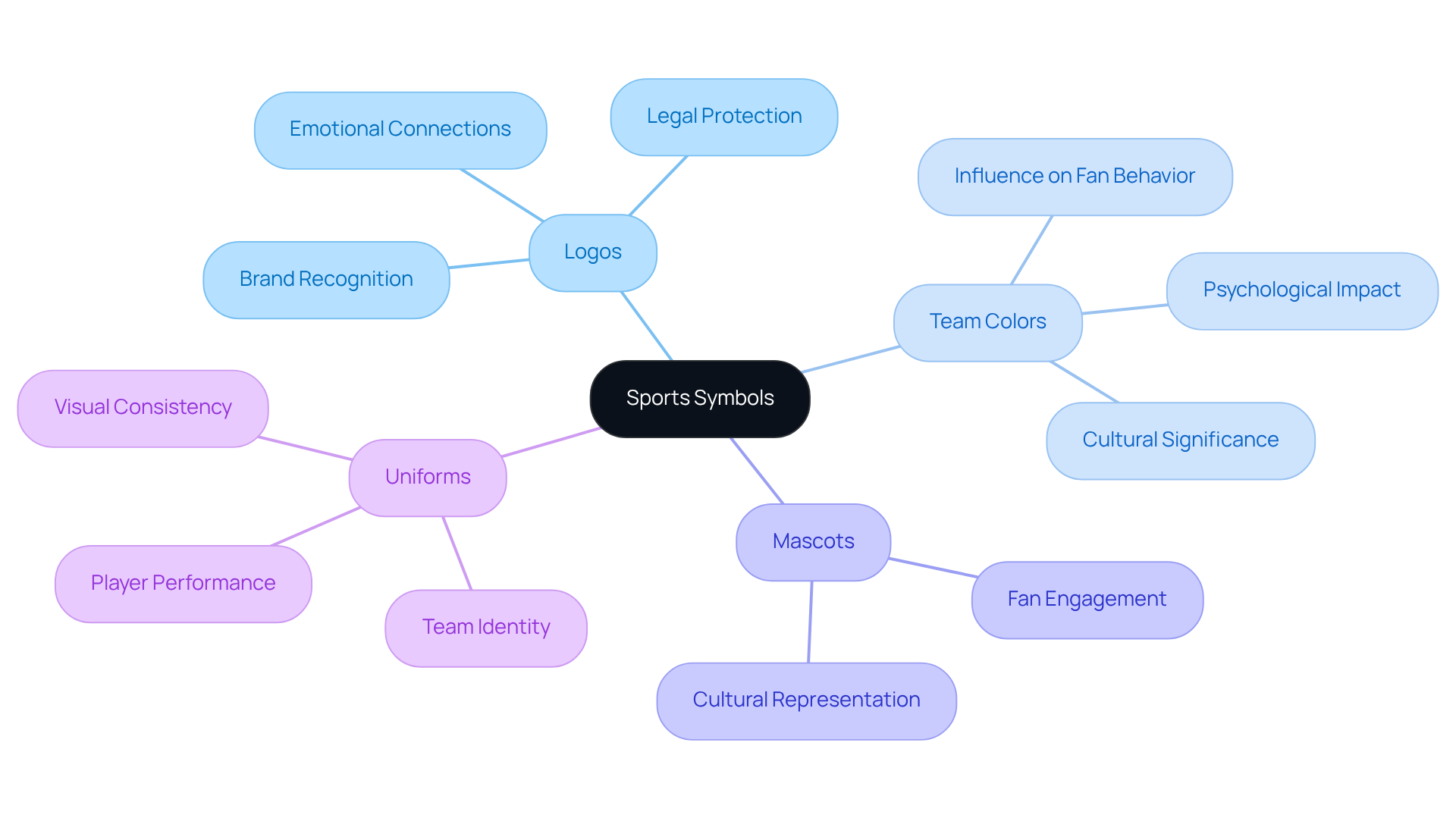
Trace the Evolution of Sports Symbols: Historical Context
The journey of developing athletic emblems is deeply rooted in ancient cultures, where symbols served to represent groups and fighters in contests. Over time, as structured athletics emerged, these groups began to adopt unique markers—colors and emblems—to distinguish themselves.
It's noteworthy that studies reveal 33% of Major League Baseball (MLB) franchises utilize a red and blue color scheme, underscoring the vital role color plays in athletic branding. The late 19th and early 20th centuries marked a significant shift with the rise of professional athletic leagues, leading to the formalization of branding for teams.
Take, for example, , which has stood the test of time since the early 1900s, representing not just the club, but also the spirit of the city itself. Phil Knight, co-founder of Nike, poignantly expressed the importance of branding when he stated, "The brand’s name, inspired by Nike, the Greek goddess of victory, reflects its goal to connect its products with success in athletics."
In today's digital age, the landscape of athletic branding has evolved dramatically, with social media platforms allowing organizations to engage fans in innovative ways, making icons more dynamic and interactive. This historical perspective sheds light on the crucial role emblems play in fostering community and identity within the athletic realm, as they not only represent teams but also connect fans to a shared experience.
For tech startup founders, understanding these branding strategies can be incredibly beneficial in carving out their own unique identities in the digital marketplace. By embracing the lessons learned from athletic branding, founders can nurture their brands with empathy and connection, ultimately fostering a sense of belonging in their communities.
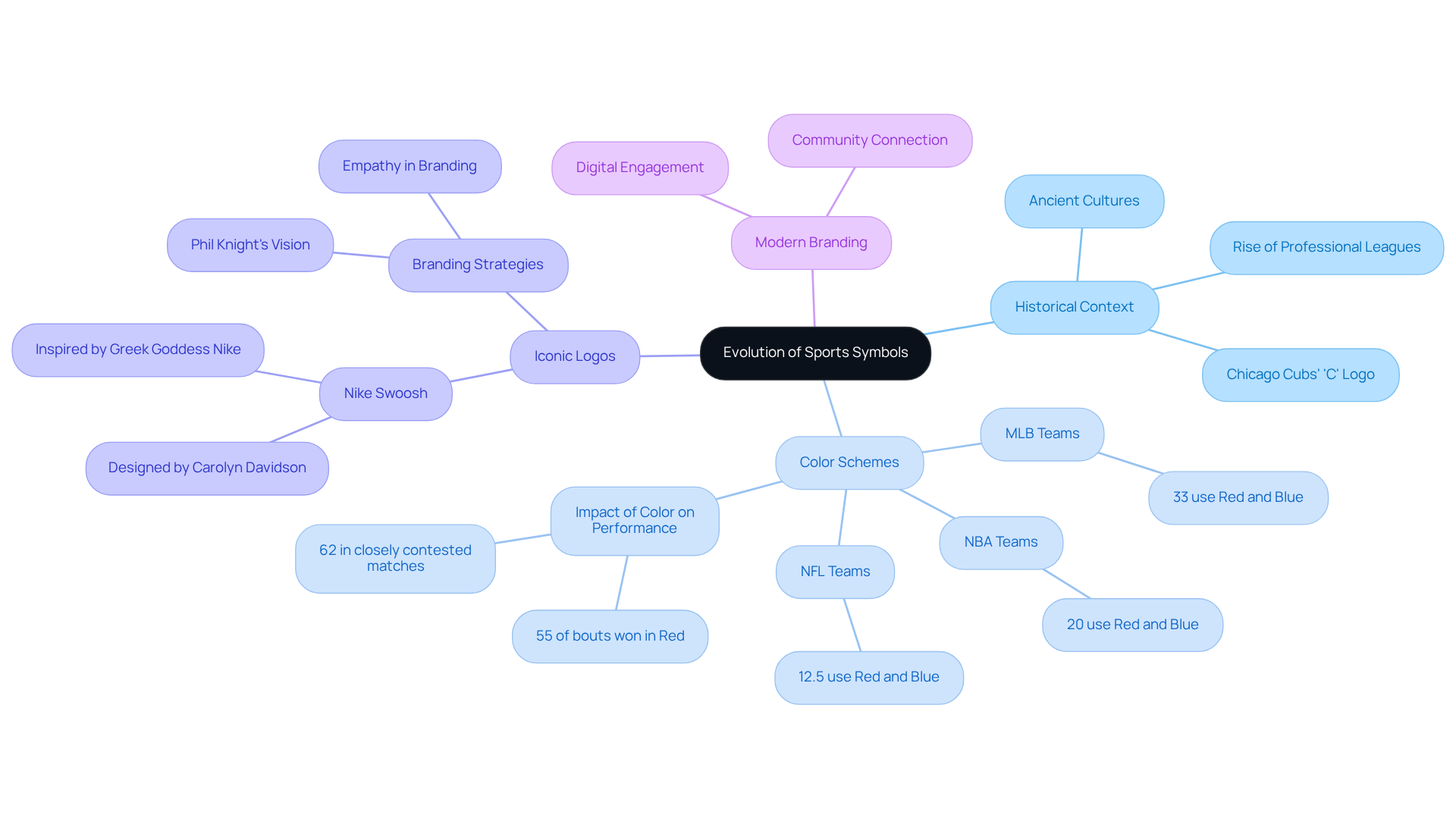
The Role of Color in Sports Symbols
Color plays a pivotal role in symbols in sports, chosen not only for aesthetic appeal but also for its profound psychological effects. It’s important to recognize how hues can provoke particular emotions and actions among both supporters and competitors. For instance, red is frequently associated with energy and aggression, making it a preferred option for groups that aim to express strength and competitiveness. In fact, red is the most popular team hue across sports, and iconic teams like the Chicago Bulls and Manchester United have harnessed the power of red as symbols in sports to forge a compelling brand identity, symbolizing passion and success.
Moreover, the strategic use of hues significantly impacts merchandise sales and fan loyalty. Groups that consistently employ particular design schemes tend to experience improved brand recognition and emotional connection from their supporters. Research shows that lively hue combinations can enhance merchandise sales, as supporters are more inclined to buy items that represent their group's shades. Additionally, groups donning darker uniforms may possess a potential victory edge over those in lighter shades, further highlighting the competitive nature of hue selection in athletics. This connection between hues and consumer behavior underscores the , which influence perceptions and nurture enduring emotional bonds with supporters, ultimately strengthening the team's identity and community spirit. A modern instance is Alexander Zverev, who donned a striking red ensemble during the 2025 Australian Open, demonstrating how color can influence perception and performance in athletic competitions.
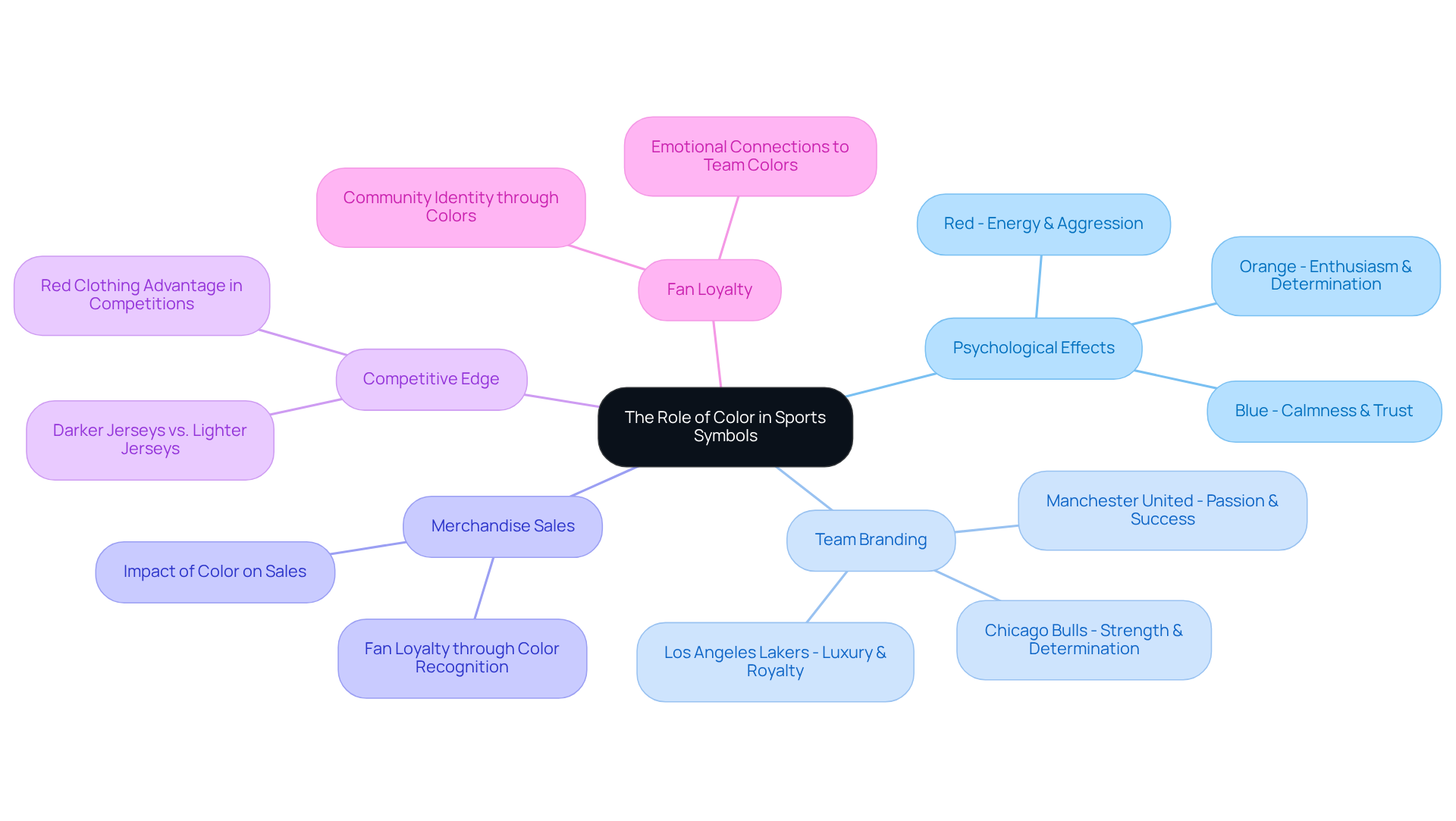
Controversies Surrounding Sports Symbols
The ongoing debates surrounding symbols in sports highlight a significant problem: cultural appropriation and representation issues. The use of symbols in sports, such as Native American imagery and names by athletic teams, has sparked considerable discussion, with many advocates urging for change due to the potential continuation of harmful stereotypes.
For instance, the Washington Redskins faced immense pressure to rebrand, a decision that underscores the growing recognition of the need for cultural sensitivity in athletics. In 2005, the American Psychological Association (APA) called for the immediate retirement of all American Indian mascots, images, and personalities, citing extensive research on the detrimental effects of racial stereotyping on self-esteem and social identity among American Indian youth. This reflects a broader societal shift towards .
Teams like the Cleveland Indians, now known as the Guardians, have also rebranded in response to these cultural sensitivities. Furthermore, the Stockbridge-Munsee Tribal Council adopted a resolution opposing race-based Indian logos, with a vote of 4 members for, 2 against, and 0 abstaining, emphasizing the organized opposition to such mascots.
These controversies highlight the responsibility that athletic organizations have in selecting symbols in sports that honor diverse cultural narratives and promote inclusivity. As cultural values evolve, so too must the representations that reflect them, making it essential for groups to engage in meaningful conversations about their branding choices.
The Morgantown High School mascot issue further illustrates the ongoing debate, as communities actively challenge the use of Native American imagery. The Mohegan Tribal Council's statement, "It is demeaning to be relegated to a stereotyping of a people," poignantly underscores the emotional impact of these mascots and the urgent need for respectful representation.
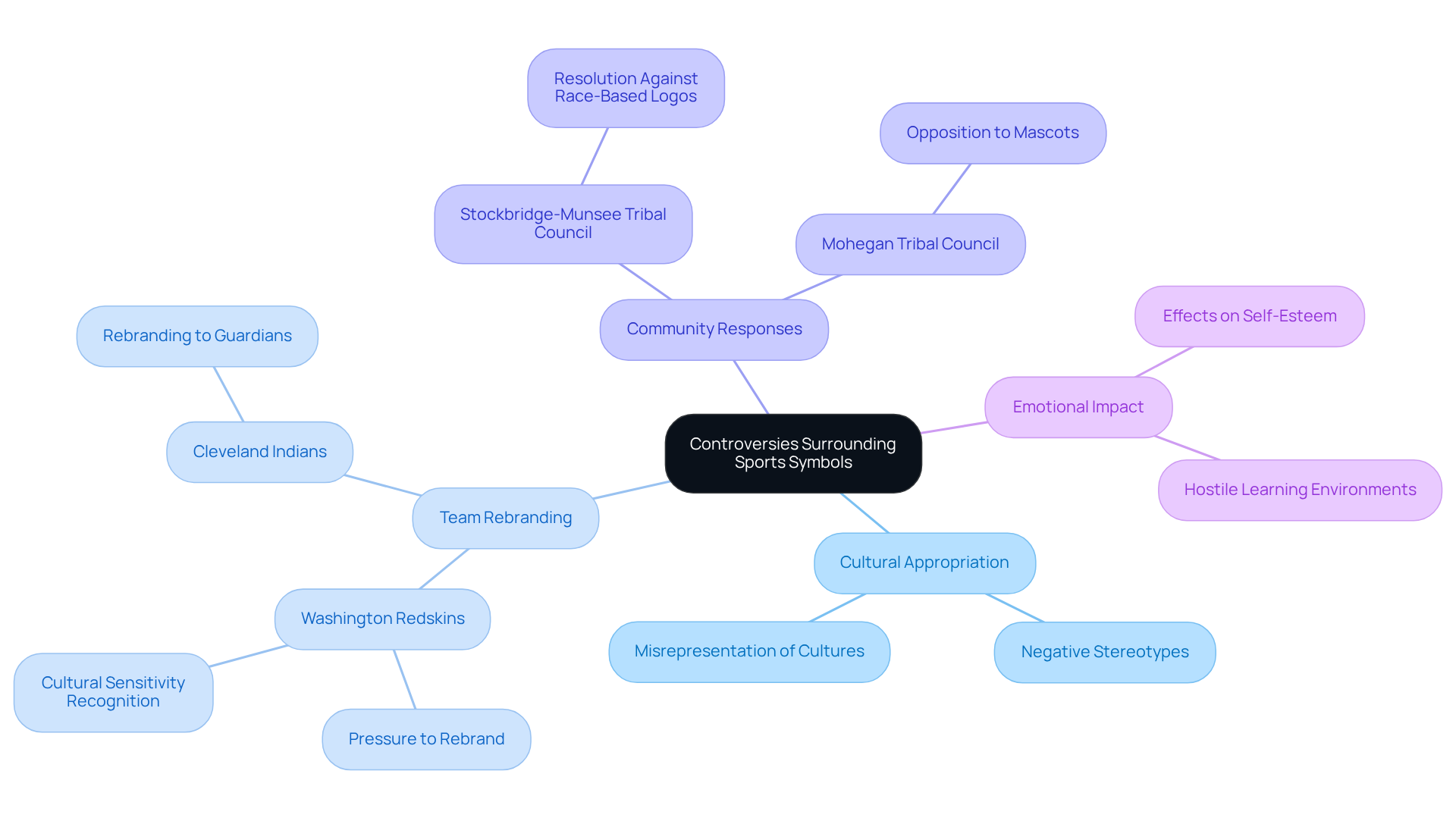
The Future of Sports Symbols in a Digital Age
As technology progresses, many sports organizations face the challenge of evolving their emblems in response to digital innovations and changing fan expectations. This shift can feel overwhelming, but it also presents a wonderful opportunity to enhance fan experiences. Augmented reality (AR) and virtual reality (VR) are becoming vital resources, allowing organizations to create immersive environments where representations can genuinely come to life. Research shows that 70.6% of smartwatch users reported positive effects on their physical activity, highlighting the growing desire for interactive digital engagement from fans.
In this dynamic landscape, sports organizations are turning to social media platforms to foster deeper connections with fans, making representations more engaging and participatory. For example, Borussia Dortmund has successfully harnessed user-generated content to build a sense of community around their emblems, strengthening ties with supporters. This approach not only cultivates but also inspires supporters to actively participate in the narrative of their organizations.
As the world of athletic branding continues to evolve, it’s essential for organizations to remain adaptable, ensuring their symbols in sports resonate with a digitally-savvy audience while honoring the core values that define their identity. The integration of AR and VR technologies isn’t just a passing trend; it represents a fundamental shift in how teams connect with their fans, paving the way for a more interactive and immersive future. Moreover, as sports organizations increasingly recognize their environmental responsibilities, incorporating sustainable practices alongside technological advancements will be crucial in shaping the future of sports branding.
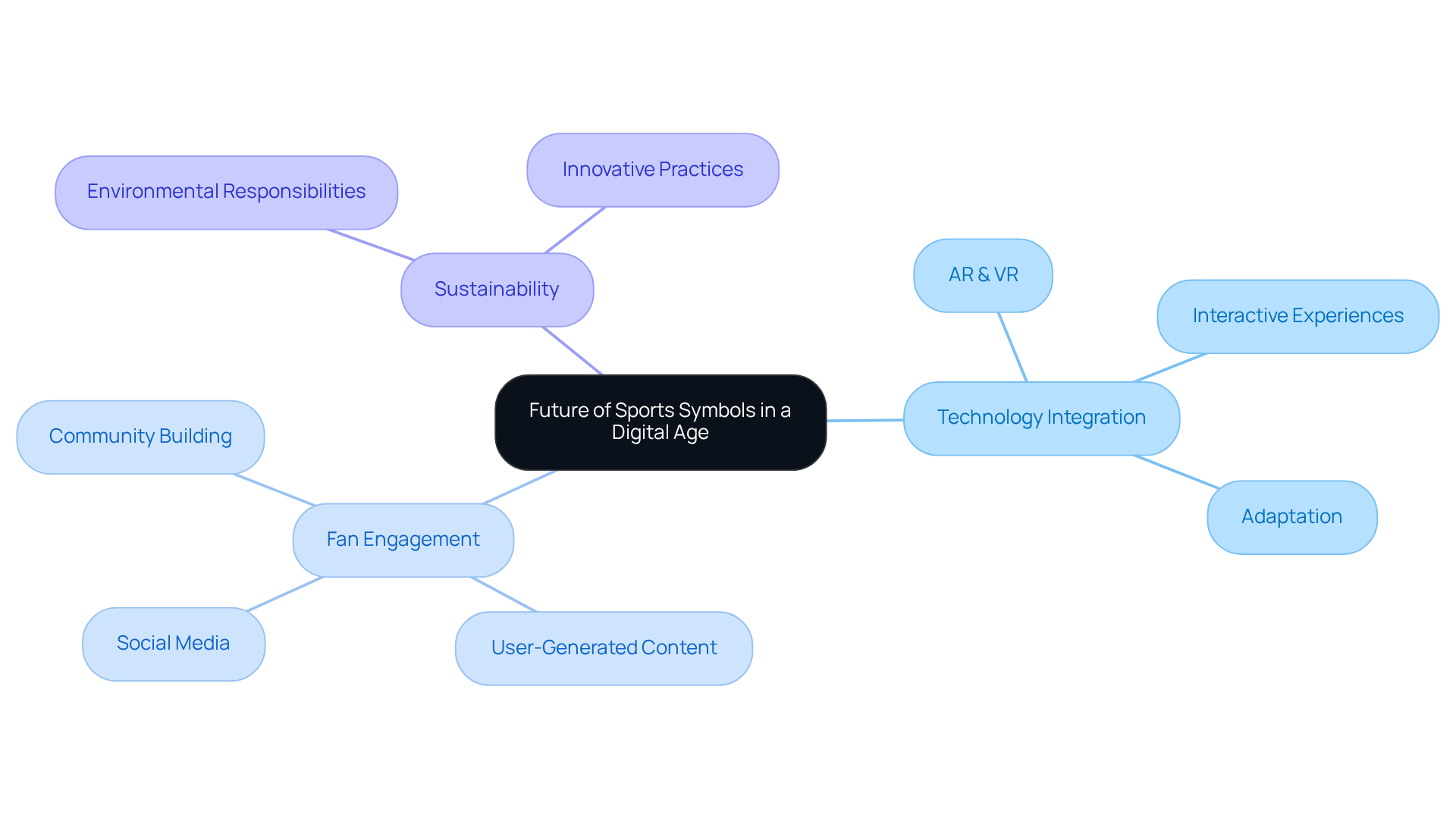
Conclusion
Symbols in sports are not just mere representations; they embody identity, community, and the emotional bonds that fans and teams share. These visual elements, from logos and team colors to mascots and uniforms, play a crucial role in enhancing brand recognition while nurturing a sense of belonging and loyalty among supporters. By understanding the significance of these symbols, we can better appreciate their impact on shaping the culture of sports and the experiences of those who engage with them.
As we delve into the evolution of sports symbols, we uncover their historical roots, the psychological effects of color choices, and the contemporary debates surrounding cultural representation. This journey reveals how symbols have evolved from basic identifiers into intricate emblems that reflect the spirit of teams and their communities. Furthermore, with the rise of digital advancements, the future of sports symbols promises innovative engagement strategies that will resonate with modern audiences, all while honoring their core values.
In this ever-changing landscape, sports organizations face both challenges and opportunities brought about by technological progress and cultural shifts. It is essential to approach branding with sensitivity and creativity, recognizing the importance of inclusivity and representation. Teams hold the responsibility to honor diverse narratives through their symbols, and by embracing these changes, they can strengthen connections with fans and contribute to a more respectful and inclusive sporting culture. Together, we can foster a community that celebrates the rich tapestry of identities within sports, ensuring that every voice is heard and valued.
Frequently Asked Questions
What are sports symbols and their significance?
Sports symbols include logos, team colors, mascots, and uniforms that represent a sports team or organization. They play a crucial role in fostering a sense of belonging among fans, enhancing brand recognition, and creating emotional connections.
How do colors influence fan behavior in sports?
Team colors can significantly influence fan behavior and perceptions. Research in color psychology indicates that certain hues can elevate team spirit and loyalty, highlighting the power of these emblems in sports.
What historical context surrounds the evolution of sports symbols?
The development of athletic emblems dates back to ancient cultures, where symbols represented groups and fighters. As structured athletics emerged, unique markers like colors and emblems were adopted for identification, particularly during the rise of professional athletic leagues in the late 19th and early 20th centuries.
Can you provide an example of a well-known sports symbol?
The Chicago Cubs' iconic 'C' logo is an example that has stood the test of time since the early 1900s. It represents not only the club but also the spirit of the city of Chicago.
How has the digital age impacted athletic branding?
In today's digital age, athletic branding has evolved dramatically due to social media platforms, allowing organizations to engage fans in innovative ways, making icons more dynamic and interactive.
What can tech startup founders learn from athletic branding?
Tech startup founders can benefit from understanding athletic branding strategies to carve out unique identities in the digital marketplace. By embracing lessons from athletic branding, they can nurture their brands with empathy and connection, fostering a sense of belonging in their communities.




